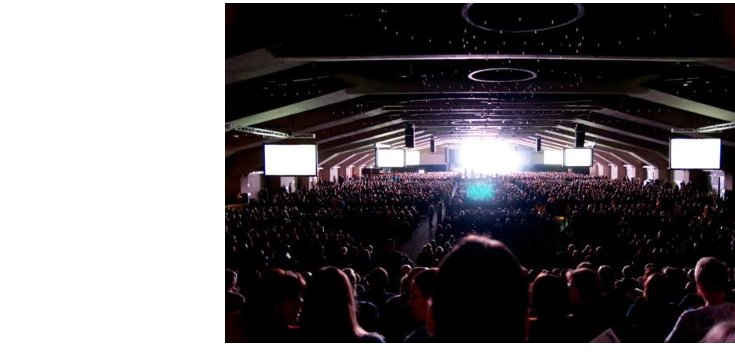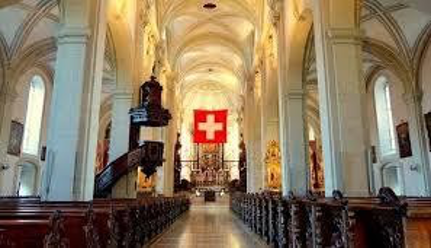
![]() Megachurches continue to grow in attendance, even as these congregations are subdividing into smaller satellite churches, according to a study by Scott Thumma and Warren Bird. The Hartford Institute for Religion Research-based study confirmed that the majority of participants continue to be white and college educated, although these racial patterns are changing. While megachurches experience people leaving the pews, nearly two-thirds have been at their churches for more than 5 years. The growth in racial diversity in megachurches has increased markedly; only two decades ago, 21 percent of megachurches were multiracial, while today half of them (58 percent) are. The expansion of megachurches shows up mainly in the growth of separate worship services offered weekly across their multisite campuses. Back in 2000, 23 percent of megachurches were multisite, but now 70 percent have adopted this strategy. The commitment of megachurches to church planting is seen in growth of this activity; only 18 percent of megachurches claimed to have helped start or plant a new church between 2010 to 2015, but almost half (48 percent) said they done so in the last 5 years (2016 to 2020).
Megachurches continue to grow in attendance, even as these congregations are subdividing into smaller satellite churches, according to a study by Scott Thumma and Warren Bird. The Hartford Institute for Religion Research-based study confirmed that the majority of participants continue to be white and college educated, although these racial patterns are changing. While megachurches experience people leaving the pews, nearly two-thirds have been at their churches for more than 5 years. The growth in racial diversity in megachurches has increased markedly; only two decades ago, 21 percent of megachurches were multiracial, while today half of them (58 percent) are. The expansion of megachurches shows up mainly in the growth of separate worship services offered weekly across their multisite campuses. Back in 2000, 23 percent of megachurches were multisite, but now 70 percent have adopted this strategy. The commitment of megachurches to church planting is seen in growth of this activity; only 18 percent of megachurches claimed to have helped start or plant a new church between 2010 to 2015, but almost half (48 percent) said they done so in the last 5 years (2016 to 2020).
(This report can be downloaded here: http://hirr.hartsem.edu/megachurch/2020_Megachurch_Report.pdf)

![]() Canada’s churches and other congregations contribute close to $15.5 billion dollars in economic benefit, with a “value equivalent to approximately 0.7 percent of Canada’s GDP, according to a study by Mark Wood Daly in the journal Studies in Religion (49:4). What has been called the “halo effect,” which is the economic benefit that religious institutions yield to their society, has been studied in the U.S. and other countries. Daly adapted the method used in the U.S. study to the Canadian context, using variables that included direct spending, open space, education, individual impact, and community development. Focusing on a pilot study of Toronto to determine the impact of Canadian congregations on their community, Daly found that the average socioeconomic benefit of each congregation was $4.5 million, with a spending index of $4.77. “In other words, for every dollar a congregation spent, the surrounding community received, on average, $4.77 in economic benefit,” he writes.
Canada’s churches and other congregations contribute close to $15.5 billion dollars in economic benefit, with a “value equivalent to approximately 0.7 percent of Canada’s GDP, according to a study by Mark Wood Daly in the journal Studies in Religion (49:4). What has been called the “halo effect,” which is the economic benefit that religious institutions yield to their society, has been studied in the U.S. and other countries. Daly adapted the method used in the U.S. study to the Canadian context, using variables that included direct spending, open space, education, individual impact, and community development. Focusing on a pilot study of Toronto to determine the impact of Canadian congregations on their community, Daly found that the average socioeconomic benefit of each congregation was $4.5 million, with a spending index of $4.77. “In other words, for every dollar a congregation spent, the surrounding community received, on average, $4.77 in economic benefit,” he writes.
 In a wider study, including 76 churches from every province, the average congregational impact was found to be approximately $2.7 million, with a median value of $2.0 million. For every dollar these congregations spend, Canadian society receives $3.87 in socioeconomic benefit. The newsletter Counting Religion in Britain (October 2020) cites a similar study for the UK, finding that its 40,300 churches generate at least 12.4 billion pounds in economic and social value each year. The study, conducted by State of Life on behalf the National Churches Trust, and found the benefits of market value and replacement cost of 2.4 billion pounds and 10 billion pounds non-market (social and wellbeing) value. The two main aspects of the latter figure are 8.3 billion pounds of wellbeing value to individuals benefitting from community good and 1.4 billion pounds wellbeing value of weekly church attendance.
In a wider study, including 76 churches from every province, the average congregational impact was found to be approximately $2.7 million, with a median value of $2.0 million. For every dollar these congregations spend, Canadian society receives $3.87 in socioeconomic benefit. The newsletter Counting Religion in Britain (October 2020) cites a similar study for the UK, finding that its 40,300 churches generate at least 12.4 billion pounds in economic and social value each year. The study, conducted by State of Life on behalf the National Churches Trust, and found the benefits of market value and replacement cost of 2.4 billion pounds and 10 billion pounds non-market (social and wellbeing) value. The two main aspects of the latter figure are 8.3 billion pounds of wellbeing value to individuals benefitting from community good and 1.4 billion pounds wellbeing value of weekly church attendance.
(Studies of Religion, https://us.sagepub.com/en-us/nam/journal/studies-religionsciencesreligieuses;Counting Religion in Britain, http://www.brin.ac.uk/wp-content/uploads/2020/11/No61-October-2020.pdf)
![]() The percentage of Catholics leaving the church in recent years is similar in Switzerland to the trends observed in other countries, writes Urs Winter-Pfändler in a new online analysis published by the Swiss Institute of Pastoral Sociology (November 19, 2020). Those leaving the church mostly make their decision between 25 and 35, but the share of those exiting between 51 and 60 is on the rise. In 2019, a record number of 31,772 Catholics left the church in Switzerland, i.e., 1.1 percent of the faithful (25 percent more than compared to 2018). In the same year, less than 1,000 adults joined the church. In many Swiss cantons, a church tax is raised by the state on behalf of religious bodies with a public law status (mostly Catholic and Reformed); thus, saving money may play a role. Indeed, in those four cantons where leaving the church has no impact on taxes, the percentage of those who leave is lower. If those four cantons are left out of the statistical data, 1.4 percent of Catholics in the remaining cantons have left the Catholic Church last year. In comparison, the percentage for 2019 was 1.2 percent in Germany and 1.3 percent in Austria, two neighboring countries. There are strong differences from one area to another, with the urban canton of Basel showing a 4.9 percent dropout rate of Catholics in 2019. In comparison, this percentage goes down below 1 percent in rural, traditionally Catholic areas.
The percentage of Catholics leaving the church in recent years is similar in Switzerland to the trends observed in other countries, writes Urs Winter-Pfändler in a new online analysis published by the Swiss Institute of Pastoral Sociology (November 19, 2020). Those leaving the church mostly make their decision between 25 and 35, but the share of those exiting between 51 and 60 is on the rise. In 2019, a record number of 31,772 Catholics left the church in Switzerland, i.e., 1.1 percent of the faithful (25 percent more than compared to 2018). In the same year, less than 1,000 adults joined the church. In many Swiss cantons, a church tax is raised by the state on behalf of religious bodies with a public law status (mostly Catholic and Reformed); thus, saving money may play a role. Indeed, in those four cantons where leaving the church has no impact on taxes, the percentage of those who leave is lower. If those four cantons are left out of the statistical data, 1.4 percent of Catholics in the remaining cantons have left the Catholic Church last year. In comparison, the percentage for 2019 was 1.2 percent in Germany and 1.3 percent in Austria, two neighboring countries. There are strong differences from one area to another, with the urban canton of Basel showing a 4.9 percent dropout rate of Catholics in 2019. In comparison, this percentage goes down below 1 percent in rural, traditionally Catholic areas.
 The analysis focuses on the canton of St. Gallen, which can be seen as representative of the average situation in Swiss German cantons. There had been a first wave of people leaving the Church in 2010, and then a second ongoing wave in recent years. They seem to be linked to the public discussions on sexual abuse, but also to Catholic sexual morality relating to the issue of divorced people who remarried and thus are banned from receiving communion, as well as concerning the position of women in the church. This raises issues of credibility for the church in segments of the population. However, a comparison with Reformed statistics (the Protestant Church used to be the largest religious body in Switzerland fifty years ago, but now occupies second rank due to a marked statistical decline) shows that losses of members are experienced by both historically established churches in Switzerland with relatively similar rates (for instance, in Basel, 3.5 percent of the Reformed left the Church in 2019). Thus, the current trend cannot be reduced to issues in the Catholic Church—it is church membership in itself that is being increasingly called into question (around 28 percent of the population had no religious affiliation in 2018, compared to 11 percent in 2000).
The analysis focuses on the canton of St. Gallen, which can be seen as representative of the average situation in Swiss German cantons. There had been a first wave of people leaving the Church in 2010, and then a second ongoing wave in recent years. They seem to be linked to the public discussions on sexual abuse, but also to Catholic sexual morality relating to the issue of divorced people who remarried and thus are banned from receiving communion, as well as concerning the position of women in the church. This raises issues of credibility for the church in segments of the population. However, a comparison with Reformed statistics (the Protestant Church used to be the largest religious body in Switzerland fifty years ago, but now occupies second rank due to a marked statistical decline) shows that losses of members are experienced by both historically established churches in Switzerland with relatively similar rates (for instance, in Basel, 3.5 percent of the Reformed left the Church in 2019). Thus, the current trend cannot be reduced to issues in the Catholic Church—it is church membership in itself that is being increasingly called into question (around 28 percent of the population had no religious affiliation in 2018, compared to 11 percent in 2000).
Source (in German): https://kirchenstatistik.spi-sg.ch/die-kirchenaustritte-in-der-katholischenkirche-unter-dem-mikroskop/